Acrylic Macaw Cages: A Comprehensive Guide
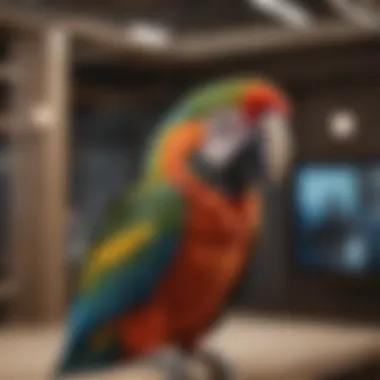

Intro
Acrylic macaw cages have gained attention among bird owners and enthusiasts for their unique properties and advantages. As large, intelligent birds, macaws require a suitable habitat that ensures their wellbeing and comfort. Choosing the right cage is crucial for both the macaw's happiness and the owner's peace of mind. This article takes a deep dive into acrylic cages, exploring their design, functionality, and multiple benefits.
Understanding these cages involves knowing their differences from traditional metal cages, their various styles, and important features that impact the macaw's health. With the right information, bird owners can better assess their options and make informed decisions regarding their avian companions.
Moreover, the following sections will touch upon essential care tips, behavioral insights, nutrition guides, wellness and health, as well as engaging activities specifically designed to enrich the life of a macaw. By providing thorough information on these areas, this guide aims to illuminate the path for both new and seasoned pet bird owners._
Preface to Acrylic Macaw Cages
Acrylic macaw cages represent a modern solution in avian housing, offering a blend of functionality and aesthetics tailored to meet the specific needs of these vibrant birds. For pet bird owners, understanding the relevance of acrylic cages is crucial. Unlike traditional cages made of metal or wire, acrylic provides visibility, durability, and a variety of design options. These features contribute not only to the comfort of macaws but also to their overall health and well-being.
The significance of acrylic cages extends beyond mere containment. They provide an environment where macaws can thrive, promoting their physical and psychological wellness. As these birds are known for their high intelligence and social nature, their habitat becomes a vital element in their daily activities.
Understanding the Needs of Macaws
Macaws are large, intelligent birds requiring a significant amount of space and mental stimulation. Their natural behavior includes climbing, exploring, and chewing. Thus, the design of an acrylic cage needs to accommodate these behaviors effectively. A well-designed cage should offer ample room for movement and play.
Macaws also thrive in stimulating environments; therefore, incorporating toys, perches, and interactive features within the acrylic structure is important. Choosing the right cage with adequate size and engaging elements helps cater to their instinctual needs, fostering a happy and healthy life.
The Role of Caging in Avian Health
Caging plays a critical role in the health and well-being of macaws. A well-structured cage can act as a sanctuary, protecting the bird from environmental hazards while providing a secure area for them to unwind. Acrylic cages have smooth surfaces that are easy to clean, reducing the risk of bacterial infections that may arise from debris or waste.
Furthermore, the transparency of acrylic allows macaws to see their surroundings, helping to reduce stress associated with confinement. When macaws feel safe and secure, they are less likely to display signs of aggression or anxiety. Thus, the right cage, like acrylic macaw cages, can have a direct impact on their behavioral health, promoting a more balanced disposition.
In summary, the introduction to acrylic macaw cages is not just about the material used but about creating the best environment for these intelligent birds to flourish. The right choice in caging is integral to fulfilling their needs and ensuring their well-being.
Materials Used in Acrylic Cages
The choice of materials used in crafting cages for macaws plays a crucial role in the overall well-being of these birds. Acrylic cages have gained popularity due to their unique properties. When analyzing these cages, it is imperative to understand the benefits and considerations that come with the materials chosen. Acrylic is a powerful choice, contrasting significantly with traditional cage materials like metal or wood.
Acrylic vs. Other Cage Materials
Acrylic cages stand out when compared to metal and wood models. They provide excellent visibility for both the bird and the owner. Unlike metal cages, acrylic promotes a secure environment, as its solid structure minimizes the risk of injuries that can occur from bar spacing. Furthermore, the smooth surface of acrylic is easier to clean than wood, which may absorb moisture and stain over time.
However, there are drawbacks to consider. Metal cages, like those made from stainless steel, offer durability and strength that acrylic cannot match. These metal cages resist wear and tear from beaks and claws better than acrylic does. Furthermore, wood can provide a more natural feeling for macaws, though it may require more maintenance.
Durability and Safety Considerations
Durability is a pressing concern for any pet owner. Acrylic, while strong, can scratch easily and may not endure rough handling. Owners should prioritize cages that offer a balance of durability and aesthetics. It is pertinent to evaluate the cage’s thickness as this can significantly affect its resistance to damage.
Safety is equally important. Acrylic cages need to meet safety standards to ensure the well-being of your macaw. Check for certifications or test reports on the specific product chosen. An important factor is the cage's design. Cages with reinforced corners and secure latching mechanisms ensure that macaws cannot escape or get stuck.
"When selecting a cage, consider long-term usage. Choose materials that withstand daily activity from your macaw while ensuring safety in the environment."
Moreover, owners should be aware of heat sensitivity. Acrylic does not insulate well and can hold heat more than metal cages. This can raise concerns during hotter seasons, which may lead to a need for more frequent environmental assessments.
Design Features of Acrylic Macaw Cages
The design features of acrylic macaw cages play a vital role in ensuring not only the aesthetic appeal but also the safety and well-being of these birds. A well-designed cage contributes significantly to the physical environment where macaws live. It can enhance their quality of life, helping them thrive in both physical health and psychological well-being. Each aspect of the cage's design should cater to the unique needs of macaws, reflecting their natural behaviors and offering sufficient stimulation.
Spatial Requirements for Macaws
Space is one of the most critical factors in the selection of a macaw cage. Macaws are large birds, often requiring considerable room to move, stretch, and play. The general recommendation is to provide a cage that is at least four feet long, three feet wide, and three feet high. This size accommodates their need for wing flapping and allows for comfortable perching.
Acrylic cages often offer more interior space due to their design. The transparent nature of acrylic also creates an illusion of openness, which can be particularly beneficial in smaller living spaces. This transparency allows macaws to feel less confined than they might in metal cages with bars that restrict their view. Properly designed acrylic cages should include multiple perches at varying heights to encourage climbing and exercising.
Ventilation and Airflow Considerations
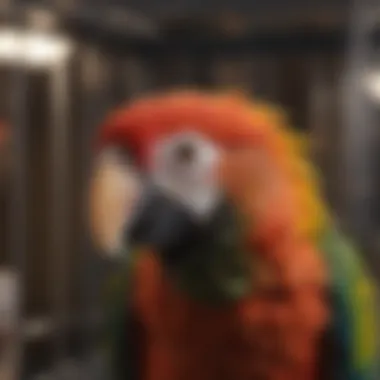
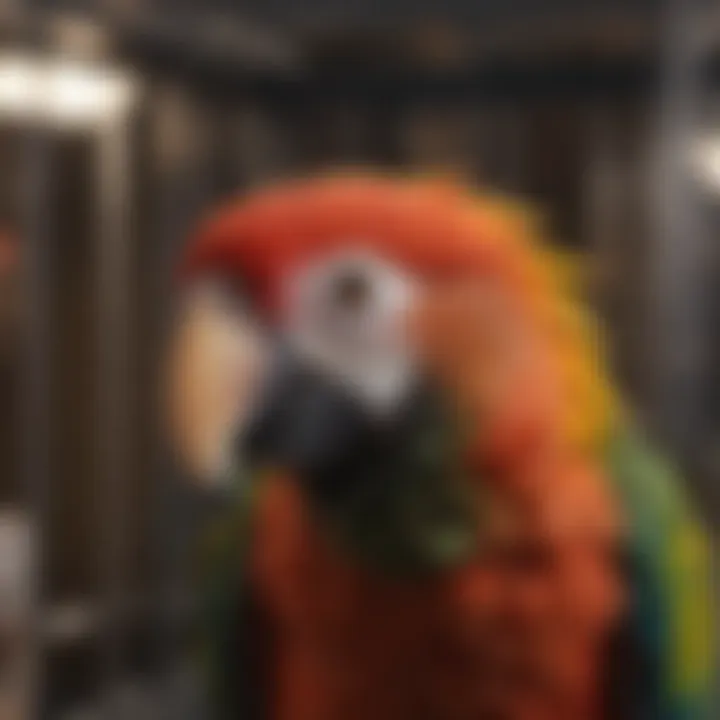
Proper ventilation is essential in any pet habitat, especially for macaws that are sensitive to air quality. Acrylic cages must be designed to ensure adequate airflow, which helps reduce the buildup of harmful ammonia and other pollutants that can affect respiratory health. One effective feature is incorporating mesh panels or openings that allow fresh air to circulate while still maintaining the advantages of acrylic, including visibility and safety.
It's important to consider the placement of these ventilation openings. They should be positioned high enough to promote upward airflow, which can effectively remove warm, stale air from the cage. Additionally, ensuring that the design allows for easy maintenance and cleaning will help keep the environment healthy for the macaw.
Visibility and Interaction with Owners
Acrylic cages can enhance visibility for both the macaw and its owner. The transparency of acrylic allows the bird to see and interact more freely with its environment, which can reduce feelings of isolation. Macaws are social creatures, and a design that encourages visible connection to their owners is critical. Owners can observe their birds easily and note their behavior and needs.
The openness of acrylic not only benefits the birds but also enriches the experience for the owners, who often seek to build a strong bond with their pets. By providing a space where interaction is easy, cages encourage more frequent engagement, which is essential in strengthening human-animal relationships. Owners should also look for cages that include features such as removable trays or platforms for easy access and cleaning, fostering a more hands-on experience.
"When looking for a macaw cage, consider both the design elements and how they affect the well-being of your bird. A well-structured space promotes interaction and health."
In summary, the design features of acrylic macaw cages are imperative for meeting the unique needs of these vibrant birds. Every aspect, from space allocation to ventilation, contributes to their overall well-being and enables owners to maintain a closer relationship with their pets.
Sizing and Customization Options
Choosing the right size and customization options for acrylic macaw cages is crucial for the health and happiness of these intelligent birds. An optimal cage size provides ample space for movement, promotes exercise, and ensures mental stimulation. Macaws are active and social creatures. Therefore, a proper size is not just a luxury; it is a necessity. Moreover, customization makes these cages more than just functional. It allows for a personalized environment tailored to the specific needs of both the macaw and the owner.
Choosing the Right Size for Your Macaw
To ensure that a macaw can live comfortably, one must consider the size carefully. A cage that is too small can lead to frustration and stress for the bird. The general recommendation for larger macaws is a cage that is at least 5 feet in height and 4 feet in width, though bigger is often better. This allows the macaw room to spread its wings fully and engage in natural behaviors such as climbing and playing.
Proper dimensions not only provide physical space but are also essential for psychological well-being. When choosing the right size:
- Consider the Species: Different macaw species have varying sizes; for instance, a Hyacinth macaw requires more space compared to a Blue-and-yellow macaw.
- Natural Behavior: Macaws naturally fly and climb. They need enough space to mimic those activities inside their cages.
- Additional Items: Think about the features that will also be in the cage, such as perches, toys, and food bowls. All of these require additional space, impacting the overall size needed.
A proper size cage enables the macaw to thrive, both physically and mentally.
Customization Features Available
Customization options in acrylic cages enhance the living experience for macaws and their owners. These features can range from aesthetic additions to functional upgrades that directly benefit the bird's daily life. The flexibility in design accommodates distinct preferences.
When exploring customization options, the following factors could be considered:
- Adjustable Shelving: This allows owners to rearrange perches and accessories to suit the changing preferences of their macaws.
- Variety of Perches: Different textures and sizes provide opportunities for exercise. Some birds prefer softer perches for resting, while others might benefit from rougher types to maintain proper foot health.
- Access Points: Multiple doors or removable panels make it easier for the owner to engage with the bird and clean the cage, supporting both interaction and maintenance.
- Color and Design: Acrylic cages come in various colors, enabling owners to match their interiors and create a more pleasant aesthetic.
Customization is key to creating an enriching environment for macaws, ultimately leading to healthier and happier birds.
In short, the right sizing and thoughtful customization of acrylic macaw cages can greatly enhance the well-being of these vibrant pets.
Maintenance of Acrylic Cages
Maintaining acrylic macaw cages is essential for promoting the health and well-being of your pet bird. Regular upkeep ensures that the cage remains a safe and enjoyable environment. Acrylic material has unique properties that can be both beneficial and challenging. Consequently, understanding the maintenance aspects of these cages is key for any macaw owner.
Regular Cleaning Routines
A regular cleaning routine is crucial for acrylic cages. The surface of acrylic can attract dust and debris, which may lead to bacteria buildup if left unchecked. Daily spot cleaning is recommended to remove any droppings or food remnants. This practice prevents unpleasant odors and safeguards your macaw's health.
Once a week, a more thorough cleaning is necessary. For this, you should consider using a gentle, bird-safe cleaner. A simple mixture of vinegar and water can be effective and safe. Use a soft cloth or sponge to wipe down all surfaces, including the bottom tray, which collects most waste.
Don't forget to clean toys and perches as well, as these can harbor bacteria. Substituting toys regularly can also help keep your macaw engaged and healthy.
Common Maintenance Issues
While acrylic cages have many benefits, they do come with some potential maintenance issues. One common issue is scratching. Acrylic can scratch easily, which may affect visibility and aesthetics. To prevent scratches, use appropriate cleaning tools and avoid abrasive cleaners.
Another concern is fogging. Over time, acrylic can develop a cloudy appearance, particularly if exposed to sunlight. To minimize fogging, position the cage in an area that avoids direct sunlight whenever possible. Regularly polishing the acrylic with a safe cleaner can also help maintain clarity.
Lastly, check for structural integrity regularly. Over time, the joints and connections may weaken. Ensuring that everything is securely fastened will prevent issues that may endanger your macaw.
In summary, meticulous maintenance of acrylic cages is critical. Routine cleaning and addressing common issues contribute to a safe and pleasant habitat for your macaw. By adopting these practices, you will enhance the longevity of the cage and the health of your pet.
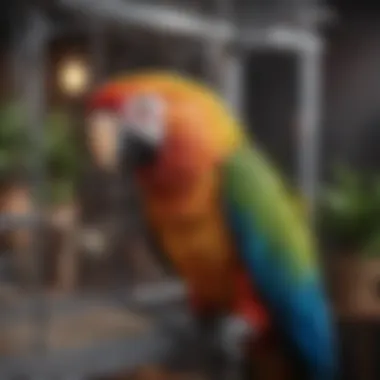
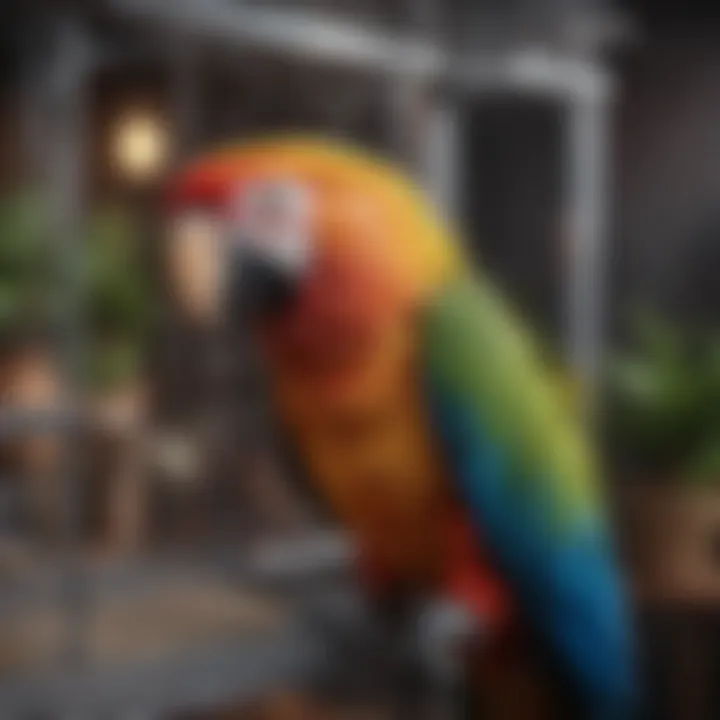
Benefits of Acrylic Cages for Macaws
Acrylic cages offer several advantages that make them a popular choice among macaw owners. Macaws have unique needs due to their size and intelligence, making it essential to provide an environment that supports their physical and mental health. Acrylic cages cater to these requirements in various ways, emphasizing the overall well-being of these remarkable birds. In addition to offering a compelling aesthetic, these cages enhance the living environment, reduce stress, and facilitate healthy interactions with their owners.
Enhanced Living Environment
The living environment plays a critical role in the health and happiness of macaws. Acrylic cages are designed to provide ample space, visibility, and comfort. One of the standout features of acrylic cages is their transparency. This allows owners to observe their macaws easily, ensuring they can monitor behaviors and well-being without causing disruption. The visual connection with their human companions is vital in building a trusting bond.
Acrylic also retains heat better than wire or metal cages. Macaws are sensitive to extreme temperatures, and acrylic provides insulation that helps maintain a comfortable climate inside the cage. This can be especially beneficial during colder months, ensuring that the birds do not experience chills. The fact that acrylic cages are also chew-resistant offers additional peace of mind for owners concerned about potential escape or injury.
Moreover, the smooth surfaces of acrylic are less prone to harboring bacteria compared to traditional metal cages. This results in a cleaner environment, which is vital for the overall health of the birds. The ease of cleaning enhances this benefit further, as owners can maintain hygiene without excessive effort.
Reduction of Psychological Stress
Psychological well-being is often overlooked in avian care, but it is as essential as physical health. Acrylic cages can contribute significantly to the reduction of psychological stress in macaws. A crucial factor is the ability for macaws to see their surroundings clearly. Unlike metal cages, which can feel enclosed and restrictive, acrylic cages give macaws a wider view, reducing feelings of confinement.
Incorporating natural elements like perches, toys, and climbing structures within the cage can further reduce stress. The flexibility of design with acrylic allows for greater customization, encouraging natural behaviors such as exploration and play. This can help mitigate issues related to boredom or confinement, which may lead to destructive behaviors.
Furthermore, having a transparent barrier between them and the external environment can reduce anxiety. For instance, if there are loud noises or sudden movements outside, the macaw can observe it without feeling threatened. This visual stimulation reduces fear and promotes a calmer demeanor in the bird.
"Choosing the right cage material significantly impacts the long-term happiness of macaws."
Potential Drawbacks of Acrylic Cages
Acrylic macaw cages are growing in popularity among bird owners. However, it is crucial to acknowledge that they have potential drawbacks. Understanding these limitations can help pet bird owners make informed decisions that prioritize their birds' health and well-being. This section highlights the more critical drawbacks and associated considerations when choosing an acrylic cage for your macaw.
Heat Sensitivity and Temperature Regulation
Acrylic is known for its insulation properties. This can be beneficial in keeping warmth inside the cage. However, it also presents a challenge in terms of temperature regulation. If the outdoor temperature fluctuates significantly, the acrylic cage can become too hot or too cold. Macaws prefer a stable environment, and extreme temperatures can lead to discomfort or health issues.
In very hot climates, direct sunlight can raise the cage's internal temperature. Pet owners need to ensure that the cage is placed in a shaded area. Likewise, during winter, owners should monitor the temperature inside the cage to prevent it from becoming too cold. Using a thermometer to check the internal environment is a practical approach.
To counteract heat sensitivity, consider the following:
- Location: Place the cage in a well-ventilated but shaded area.
- Insulation: Use insulation materials judiciously.
- Monitoring: Invest in a temperature monitoring system to detect fluctuations.
"Acrylic cages require careful placement to avoid heat and cold extremes; the well-being of your macaw depends on a stable environment."
Cost Considerations
Investing in an acrylic cage often involves a higher upfront cost compared to metal cages. While the price can vary significantly based on size and design, acrylic cages tend to be at the higher end of the spectrum. This investment can be a deterrent for some, particularly first-time bird owners or individuals on a tight budget.
Beyond the initial purchase price, ongoing costs such as maintenance, cleaning supplies, and potential repairs should also be factored in. Acrylic, if scratched or damaged, may require costly repairs or replacement. Owners need to consider not only the short-term expenses but also the long-term financial commitment associated with owning an acrylic cage.
To help in your financial planning, keep in mind the following points:
- Initial Investment: Determine budget constraints before making a selection.
- Longevity: Assess the durability of the acrylic and potential long-term costs.
- Repairs: Be prepared for possible repair or replacement costs in future.
Understanding these elements allows for a more comprehensive assessment of whether an acrylic macaw cage is the right choice for your situation.
Comparative Analysis: Acrylic vs. Metal Cages
When selecting a cage for macaws, two primary materials are under consideration: acrylic and metal. This comparative analysis focuses on the specific elements that define each type, highlighting benefits and drawbacks that arise in different circumstances. Understanding these aspects assists potential owners in making informed decisions about the most suitable option for their birds.
Structural Integrity Comparison
Acrylic cages offer a unique structural integrity when compared to metal cages. Acrylic is less prone to rust and corrosion, which is a significant advantage. This characteristic ensures that the cage maintains its appearance and functionality over an extended period. In contrast, metal cages can deteriorate if not properly maintained, leading to potential safety hazards for birds.
However, the thickness and quality of the acrylic material are important factors. High-quality acrylic provides sufficient strength, but lower-quality options may be less reliable. Owners must inspect the thickness and overall construction of the acrylic cage.
On the other hand, metal cages, particularly those made from stainless steel or powder-coated metal, offer superior structural stability. This stability can endure the heavy weight and activity levels characteristic of macaws. When considering durability in larger or more active birds, metal cages can sometimes provide a more robust option.
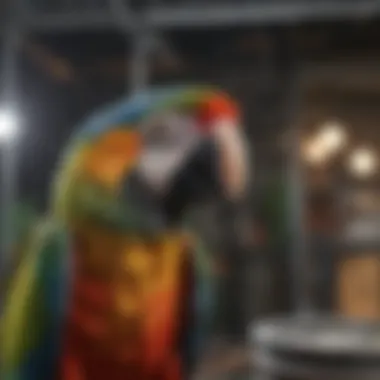
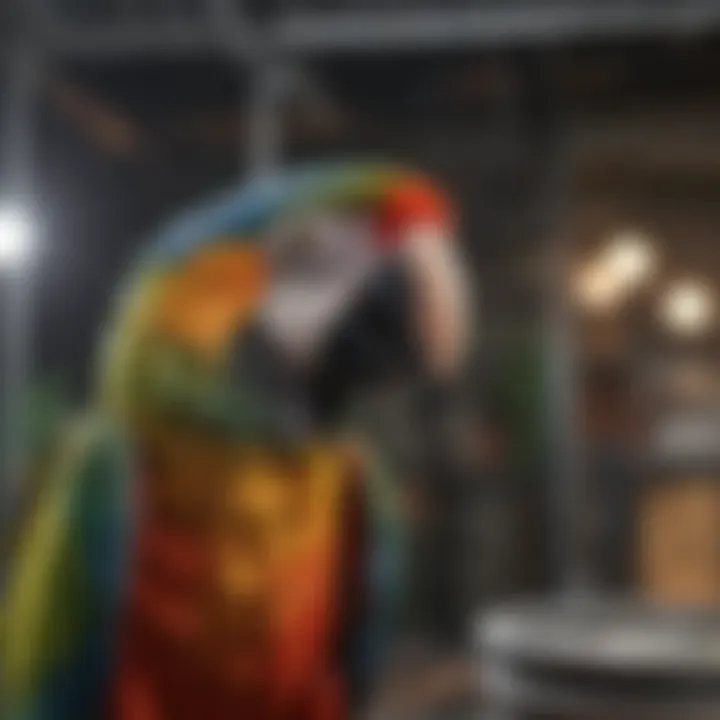
Ease of Interaction in Different Cage Types
Interactions between owners and macaws can vary significantly based on the cage type. Acrylic cages offer the advantage of visibility, allowing for easy observation of the birds without obstruction. This transparency can foster a more engaging and interactive environment for both the macaw and the owner. Birds can become accustomed to their owners and feel less isolated inside a clear cage.
Conversely, metal cages may present some challenges in terms of engagement. Although they can offer solid structures for macaws, bars may obstruct interaction. Macaws tend to be social creatures that thrive on communication. Thus, owners might find it harder to connect with their macaw in a traditional metal cage.
Both cage types can be equipped with features that enhance interaction, such as openings, perches, and toys. Ultimately, the choice between acrylic and metal cages often depends on personal preference and the specific needs of the macaw. Each material offers distinct benefits but also comes with its own set of considerations.
"Selecting the right cage involves balancing durability, aesthetics, and interaction. Understand your macaw’s personality to make the optimal choice."
Purchasing an Acrylic Macaw Cage
Purchasing an acrylic macaw cage is a significant decision for bird enthusiasts. The cage serves as both a home and a environment for macaws, affecting their physical health and psychological well-being. Given the unique needs of macaws, selecting the right cage is crucial. Besides ensuring a comfortable living space, a suitable cage can facilitate interaction between the bird and its owner. Therefore, understanding various elements surrounding the purchase is important.
Acrylic cages have specific benefits compared to traditional metal cages. They offer better visibility, allowing both the bird and the owner to interact more freely. Additionally, acrylic materials tend to be lighter, making it easier to clean and move the cage if necessary. However, factors like heat sensitivity and cost should be considered before making a final decision.
Where to Buy: Trusted Suppliers
Finding a reputable supplier for your acrylic macaw cage is necessary. Quality matters, especially since this cage will house your pet. Trusted suppliers can be found through various channels:
- Online retailers: Websites like Chewy and Amazon often have a range of options with customer reviews.
- Specialty pet stores: Local shops may offer unique selections and knowledgeable staff to answer questions.
- Avicultural shows and expos: Meeting breeders and suppliers at these events can lead to valuable recommendations.
Reviews and ratings can provide insight into the quality of products. Seek out suppliers that are known for their commitment to customer service and product reliability.
Factors to Consider Before Purchase
Before finalizing the purchase of an acrylic macaw cage, several considerations should be addressed:
- Cage Size: The dimensions should be spacious enough to accommodate the macaw's wingspan. Larger birds typically need more room to move around.
- Ventilation: Good airflow is critical for the health of the macaw. Ensure the cage design allows for adequate ventilation.
- Safety Features: Look for rounded edges and secure locks to keep your bird safe. Also, check for non-toxic materials to avoid any harmful effects.
- Customization Options: Some suppliers offer modifications like perches, feeding stations, and toys. Customization can enhance the living environment for the macaw.
- Price Range: Consider your budget while ensuring quality is not compromised. High-quality acrylic cages tend to be an investment, reflecting on their durability and safety.
"Choosing the right acrylic macaw cage enhances the happiness and health of your bird, leading to a fulfilling experience for both the pet and owner."
User Reviews and Insights
User reviews and insights play a crucial role in understanding acrylic macaw cages. When potential buyers search for a cage, they often rely on the experiences of others to make informed decisions. These evaluations provide perspective on functionality, durability, and overall satisfaction.
The significance of user insights lies in their candid nature. Owners share valuable information about how their macaws interact with the cage. They discuss practical aspects such as ease of cleaning, the structural integrity of the cage, and how well it serves its purpose of comfort and safety. Reviews can underscore elements that brochures may not cover, which helps prospective buyers weigh their options.
Key Benefits of User Reviews:
- Real-life Experiences: Owners relay details about daily usage that are not found in product descriptions.
- Versatility: Insights reveal how different breeds and sizes of macaws react to the same cage.
- Spanning Time: Long-term reviews show how cages hold up against ongoing use, which enhances understanding of durability.
By synthesizing these user insights, a clearer picture emerges about the long-term performance of specific acrylic macaw cages. It helps in establishing trust between the potential buyer and the product.
Expert Opinions on Acrylic Cages
Expert opinions on acrylic macaw cages further enhance the understanding of their value. Avian specialists and veterinarians often provide analysis based on anatomy and behavior of macaws. These insights reinforce the points made in user reviews and help buyers feel more assured in their decisions.
Professionals discuss essential features, such as visibility, ventilation, and safety measures. They often endorse features that prevent injury, like rounded edges and non-toxic materials.
Quotes from experts in avian care can emphasize crucial factors to consider:
"Choosing an appropriate cage is vital for macaws' happiness and health. An acrylic cage can minimize stress and facilitate interaction with humans."
Experts also highlight possible downsides of acrylic cages, such as heat sensitivity, which can inform buyers to monitor their environments closely.
Owner Experiences and Testimonials
Owner experiences provide authentic narratives about the use of acrylic macaw cages. These testimonials often reflect a mix of joy and challenges. They can inspire potential buyers or raise valid concerns that manage expectations.
Some owners applaud features that enhance their macaw’s quality of life. These can include:
- Visibility: Many express satisfaction with how their birds can see surroundings while being safely contained.
- Behavioral Improvements: Some owners note positive changes in their birds’ behavior due to added comfort and stimulation within their cages.
In contrast, challenges such as maintenance issues are also discussed. Owners may share their struggles with scratching or fogging while cleaning the acrylic surface.
Through these experiences, a balanced view emerges that combines joy and caution, which can assist potential buyers in making informed choices.















